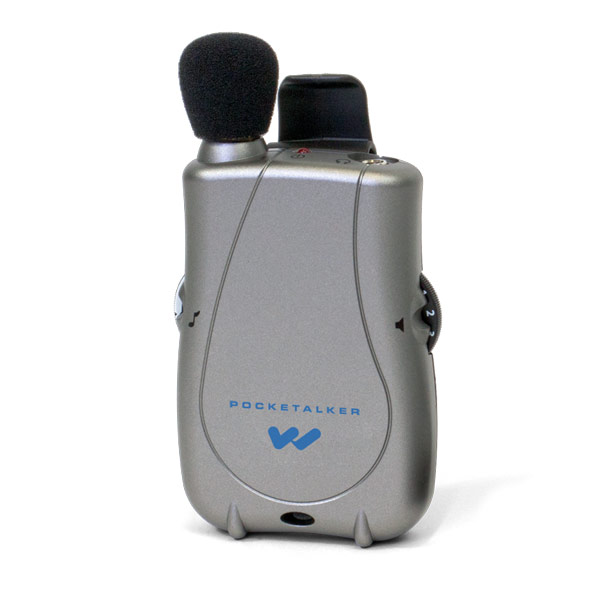There is a wide variety of amplification devices. Most of the distinctions between these products rely on how the FDA views and regulates them and their intended uses, and some of the categories overlap or are a little confusing and vague. Here are some basic definitions:
Hearing Aids

A hearing aid is “any wearable instrument or device designed for, offered for the purpose of, or represented as aiding persons with or compensating for, impaired hearing” (FDA: 21 CFR 801.420). They fall under the FDA’s medical device regulations and therefore have to get clearance prior to being marketed. There are many different types and styles of hearing aids, and these are covered in greater detail in the article, Hearing Aids: Styles, Types, and Options. While most hearing aids are dispensed by hearing care professionals, there are hearing aids that are self-fit and/or fall under what is known as the “blended care model“, where the consumer has access to an expert via the internet (and sometimes with the option of visiting a hearing care practice should they need to do so).
Personal Sound Amplification Products (PSAPs)

PSAPs are intended to amplify environmental sound for non-hearing-impaired consumers, according to the FDA. They are not intended to compensate for hearing loss. That means PSAPs are not regulated as a medical device by FDA in the same way hearing aids are—although they are subject to certain requirements for electronic products that emit sound and use wireless technology. This fact withstanding, many manufacturers market PSAPs as hearing loss compensation devices but often “skirt around” the fact that they are often used as a “starter hearing aid” for milder losses. Other uses of PSAPs include sound enhancers used for hunting, bird watching, listening to a lecture, or otherwise listening to distant/soft sounds that would be difficult for normal-hearing people to hear (eg, distant conversations or performances).
OTC Hearing Aids
Technically, as of this writing (October 2020), an over-the-counter (OTC) hearing device classification does not yet exist. The FDA is currently drafting recommendations for what this class of products will look like and how they will be regulated. OTC hearing aids—when the regulatory definitions are eventually created by the FDA—will most likely be positioned between hearing aids and PSAPs in terms of regulations. FDA has concluded that the Bose Hearing Aid should be classified as a Class II device under the generic name “self-fitting air-conduction hearing aid,” but this device is not yet available from the company. As mention above, in addition to PSAPs, there are some self-fitting or DIY hearing aids—devices actually approved by the FDA—that are available online or at pharmacies, big box stores, etc. But there currently is no such thing as an “OTC hearing aid.”
Assistive Listening Devices (ALDs)
This a broad term for a wide range of products—usually either not worn on the ear or intended for all-day use—that enhance your hearing in special situations and can be used with or without a hearing aid. Assistive listening devices or ALDs enhance hearing in places like theaters and lecture halls. Some examples are Pocket Talkers, TV listening systems, amplified/captioned telephones (which are free to qualified people with hearing loss), large-area inductive, FM and infrared listening systems, tour-guide headsets, etc. Generally speaking, these are regulated in the same way PSAPs are regulated.

Alerting and Alarm Devices for People with Hearing Loss
Like ALDs, this is a broad product class designed to help people with hearing loss—particularly when they might not be wearing their hearing aid and/or for people who have profound hearing loss or deafness. Examples include ultra-loud door-knock and vibrating alerting systems, special fire and carbon-monoxide alarms, vibrating alarm clocks or pillow shakers, and similar devices that can alert you to very important things, especially when you might not be wearing your hearing aids (eg, at night, in the shower, etc).
Summary
There are many devices available that you can use to hear well and be safe (with or without an amplification device).
So, hearing aids are devices designed to solve a hearing problem which is a medical condition. The FDA looks at a hearing aid as a “Class I” medical device (the lowest risk category in terms of safety), or a Class II device when they contain wireless/Bluetooth technology (still low risk, but the devices are required to comply with FDAs wireless safety requirements). PSAPs are designed to enhance hearing—not address an actual diagnosed hearing loss—and therefore are not covered under the FDA regulations. Although a large number of PSAPs are marketed as hearing aids, technically speaking, they’re not supposed to do so. However, the FDA and FCC have historically been pretty lax in enforcement of the PSAP rules compared to the regulations they require for hearing aid, possibly because they believe there should be greater low-cost options in amplification—and the OTC hearing aid classification is expected soon which hopefully will clarify further the regulations for all hearing devices.
ALDs and Alerting/alarm devices are two tremendously useful—and unfortunately terribly underutilized!—types of products that can greatly enhance your communication, as well as the utility of your hearing devices, while also putting your mind at ease when you might not be wearing your regular hearing devices.
Recent Comments